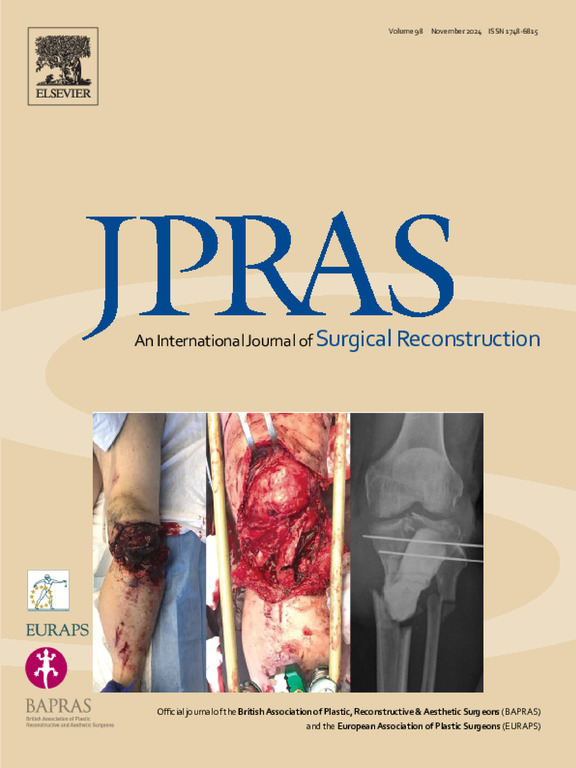Long-term breast sensation following breast augmentation: A retrospective analysis of influencing factors
IF 2
3区 医学
Q2 SURGERY
Journal of Plastic Reconstructive and Aesthetic Surgery
Pub Date : 2025-03-20
DOI:10.1016/j.bjps.2025.03.041
引用次数: 0
Abstract
Background
Breast augmentation is associated with high patient satisfaction; however, preserving breast sensation remains challenging. This study aimed to evaluate long-term breast sensation and identify factors affecting sensation following breast augmentation.
Methods
This retrospective study included breast augmentation patients (experimental group) and an unoperated control group to evaluate the sensory changes following surgery. Sensory assessments were conducted using the Semmes–Weinstein monofilament test at 9 specific points on each breast, measuring central, peripheral and total sensory values. Comparisons of the sensory outcomes were made between the experimental and control groups, as well as within the experimental group. Factors such as smoking, systemic diseases, pregnancy, breastfeeding, implant plane, implant size and type and complications were analysed for their impact on sensation.
Results
The study included 55 breast augmentation patients (110 breasts) and 20 controls (40 breasts). Sensory outcomes were significantly better in controls than in the operated group. Smoking, systemic diseases, implant size and type showed no significant impact on sensation. Pregnancy and breastfeeding were associated with better central sensation, whereas peripheral sensation was unaffected. Subglandular placement preserved central sensation better than dual-plane 2 and 3 placements but significantly reduced peripheral sensation. Post-operative complications were linked to decreased central sensation.
Conclusions
Breast augmentation is associated with decreased sensation compared to controls. Subglandular placement preserves central sensation better than dual-plane placement. Smoking, systemic diseases and implant size and type were not significantly related to sensory outcomes, while post-operative surgical complications were associated with diminished central sensation.
隆胸术后长期乳房感觉:影响因素的回顾性分析
背景隆胸与高患者满意度相关;然而,保持乳房的感觉仍然具有挑战性。本研究旨在评估隆胸术后的长期乳房感觉,并确定影响乳房感觉的因素。方法回顾性研究隆胸患者(实验组)和非隆胸患者(对照组)术后感觉变化。感官评估采用Semmes-Weinstein单丝试验在每个乳房的9个特定点进行,测量中心、外周和总感官值。对实验组和对照组之间以及实验组内部的感觉结果进行了比较。分析吸烟、全身性疾病、妊娠、哺乳、种植体平面、种植体大小和类型以及并发症等因素对感觉的影响。结果本研究纳入55例隆胸患者(110个乳房)和20例对照组(40个乳房)。对照组的感觉功能明显优于手术组。吸烟、全身性疾病、种植体大小和类型对感觉无显著影响。怀孕和哺乳与中枢感觉的改善有关,而外周感觉则不受影响。腺体下放置比双平面2和3放置更好地保留了中枢感觉,但明显减少了周围感觉。术后并发症与中枢感觉减退有关。结论与对照组相比,隆胸与感觉减退有关。腺体下放置比双平面放置更能保留中枢感觉。吸烟、全身性疾病和植入物的大小和类型与感觉结果无显著相关,而术后并发症与中枢感觉减弱有关。
本文章由计算机程序翻译,如有差异,请以英文原文为准。
求助全文
约1分钟内获得全文
求助全文
来源期刊
CiteScore
3.10
自引率
11.10%
发文量
578
审稿时长
3.5 months
期刊介绍:
JPRAS An International Journal of Surgical Reconstruction is one of the world''s leading international journals, covering all the reconstructive and aesthetic aspects of plastic surgery.
The journal presents the latest surgical procedures with audit and outcome studies of new and established techniques in plastic surgery including: cleft lip and palate and other heads and neck surgery, hand surgery, lower limb trauma, burns, skin cancer, breast surgery and aesthetic surgery.

 求助内容:
求助内容: 应助结果提醒方式:
应助结果提醒方式:


